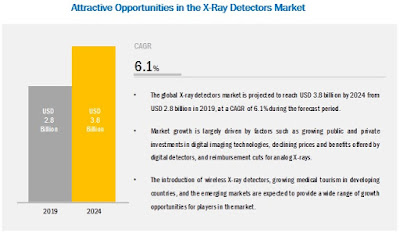According to the new market research report Defibrillators Market is
projected to reach USD 10,883.3 million by 2022 from USD 9,323.5
million in 2017 at a CAGR of 3.1%. Factors such as technological
advancements in defibrillators, increasing burden of target diseases,
growing focus on providing public-access defibrillators, and rising
number of training & awareness programs on defibrillators are
driving the growth of this market.
The report analyzes the global market by product, end user, and region.
The
implantable cardioverter defibrillators (ICDs) segment is expected to
account for the largest share of the defibrillators market, by product
type, in 2017
On
the basis of products, the market is classified into implantable
cardioverter defibrillators (ICDs) and external defibrillators. The ICDs
product segment is bifurcated into transvenous implantable cardioverter
defibrillators (T-ICDs) and subcutaneous implantable cardioverter
defibrillators (S-ICDs). The T-ICDs segment is further classified into
single-chamber ICDs, dual-chamber ICDs, and cardiac resynchronization
therapy defibrillators (CRT-Ds). The external defibrillators segment is
further classified into manual external defibrillators, automated
external defibrillators (AEDs), and wearable cardioverter defibrillators
(WCDs).
This
report covers the defibrillators market data across four major
geographies, namely, North America, Europe, Asia Pacific, and the Rest
of the World (RoW). North America is expected to account for the largest
share of the global market in 2017, followed by Europe. The large share
in the North American region is mainly attributed to the rising
incidence of target diseases in the region, technological advancements
in defibrillators, and increasing number of public defibrillation
programs in the region. Factors such as the rapidly growing aging
population, increasing cases of cardiovascular diseases, improving
research infrastructure, and growing focus of key market players to
expand their presence in this region are driving the growth of the Asia
Pacific market.
Download PDF Brochure: https://www.marketsandmarkets.com/pdfdownloadNew.asp?id=549
North America dominated the global defibrillators market in 2017
The
large share of the North American market can mainly be attributed to
the continuous technological advancements and product innovations,
increasing number of public defibrillation programs, and rising focus of
key players to expand their business in the North American region.
ZOLL
Medical (US) held the leadership position in the global external
defibrillators market. The company adopted new product launches,
agreements, and partnerships as its core business strategies to enhance
its share in the global external market. Other prominent players in the
global external market included Philips (Netherlands), Physio-Control
(US), Cardiac Science (US), Nihon Kohden (Japan), SCHILLER
(Switzerland), Mindray Medical (China), Mediana (South Korea), METRAX
(Germany), and METsis (Turkey).
